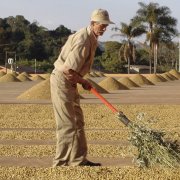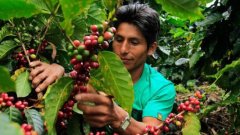Introduction to the flavor and taste of Chagg AA Coffee at Mosi Manor in Mount Kilimanjaro, Tanzania
Tanzania, which is adjacent to Kenya, produced coffee that was once famous for its extraordinary quality and unique taste, and was loved by coffee lovers. Later, under the influence of the national political situation, the coffee industry is declining day by day. In recent years, there is a warming trend, which still makes people look forward to it.
Kilimanjaro is the highest mountain range in Africa, running through northeastern Tanzania. The fertile volcanic ash soil of the land provides natural convenience for coffee planting. Affected by the volcanic ash soil, the coffee beans produced by Kilimanjaro have a unique cocoa aroma and a strong glycolic degree.
The most famous coffee bean in Tanzania is Chagg AA coffee (Ghagga AA) in the Moshi producing area of Mount Kilimanjaro. This kind of coffee bean is of good quality, rich aroma and sour taste, and the extracted coffee contains the aroma of wine and fruit, which makes people taste it.
Coffee beans produced in Tanzania are quality controlled by the Kilimanjaro Alliance, abbreviated as KNCU (Kilimanjaro Cooperative Union), and then acquired by the National Coffee Management Commission and sold to private exporters. Nowadays, individuals and groups can negotiate business with manor owners and farmers directly. The grading of coffee beans in this country is similar to that in Kenya, but there is still a slight distinction.

Important Notice :
前街咖啡 FrontStreet Coffee has moved to new addredd:
FrontStreet Coffee Address: 315,Donghua East Road,GuangZhou
Tel:020 38364473
- Prev

Coffee cultivation quality in Tanzania Coffee Farmers' Economic Environment Coffee Export
Tanzania's main coffee producing area is located at the foot of Mount Kilimanjaro, which is rich in volcanic soil. Some of the coffee trees planted here are more than 100 years old. Coffee was first introduced by Christians from Kenya to grow coffee. Coffee trees must be carefully taken care of, weeded and fertilized. And the old branches must be cut off so that they can grow new ones to maintain the coffee beans.
- Next

The Tara Pearl producing area of Costa Rica introduces the reasons for the excellence of Costa Rican boutique coffee.
Costa Rica is located in the volcanic belt of the low latitudes of Central America, with the central plateau and mountains about 800 to 2000 meters above sea level. The climate here has two obvious dry and wet seasons. The harvest period is from November to March of the following year, which coincides with the dry season, and coffee fruits of high quality and consistent maturity can be harvested. The dry season also provides sunshine conditions for the sun treatment, in the rainy season.
Related
- Does Rose Summer choose Blue, Green or Red? Detailed explanation of Rose Summer Coffee plots and Classification in Panamanian Jade Manor
- What is the difference between the origin, producing area, processing plant, cooperative and manor of coffee beans?
- How fine does the espresso powder fit? how to grind the espresso?
- Sca coffee roasting degree color card coffee roasting degree 8 roasting color values what do you mean?
- The practice of lattes: how to make lattes at home
- Introduction to Indonesian Fine Coffee beans-- Java Coffee producing area of Indonesian Arabica Coffee
- How much will the flavor of light and medium roasted rose summer be expressed? What baking level is rose summer suitable for?
- Introduction to the characteristics of washing, sun-drying or wet-planing coffee commonly used in Mantenin, Indonesia
- Price characteristics of Arabica Coffee Bean Starbucks introduction to Manning Coffee Bean Taste producing area Variety Manor
- What is the authentic Yega flavor? What are the flavor characteristics of the really excellent Yejasuffi coffee beans?

